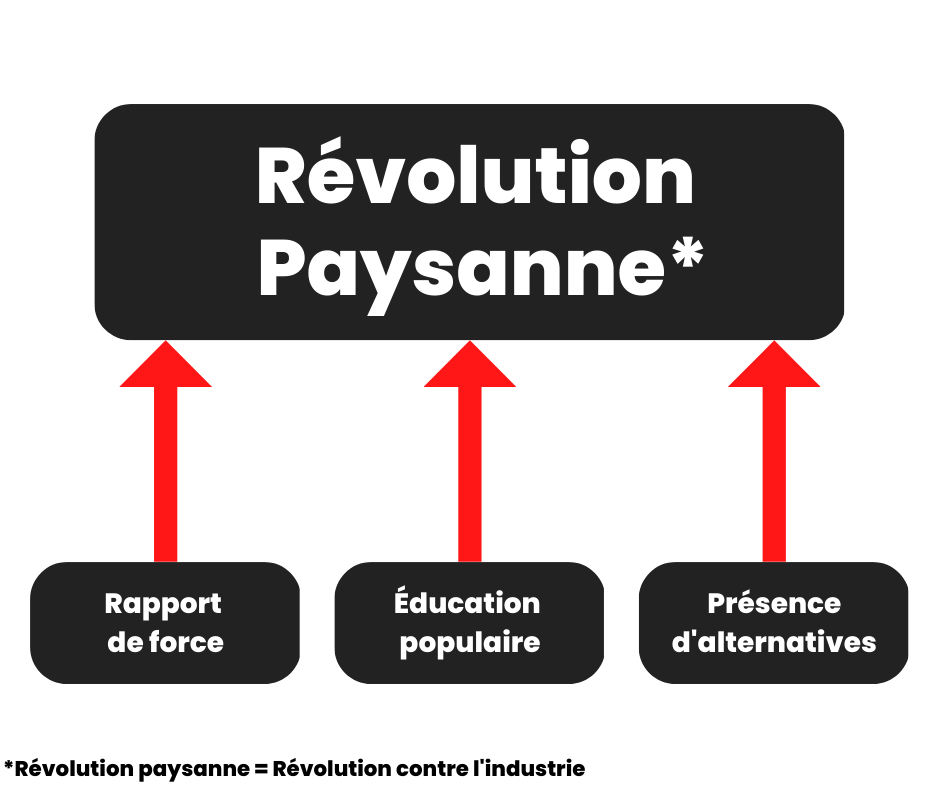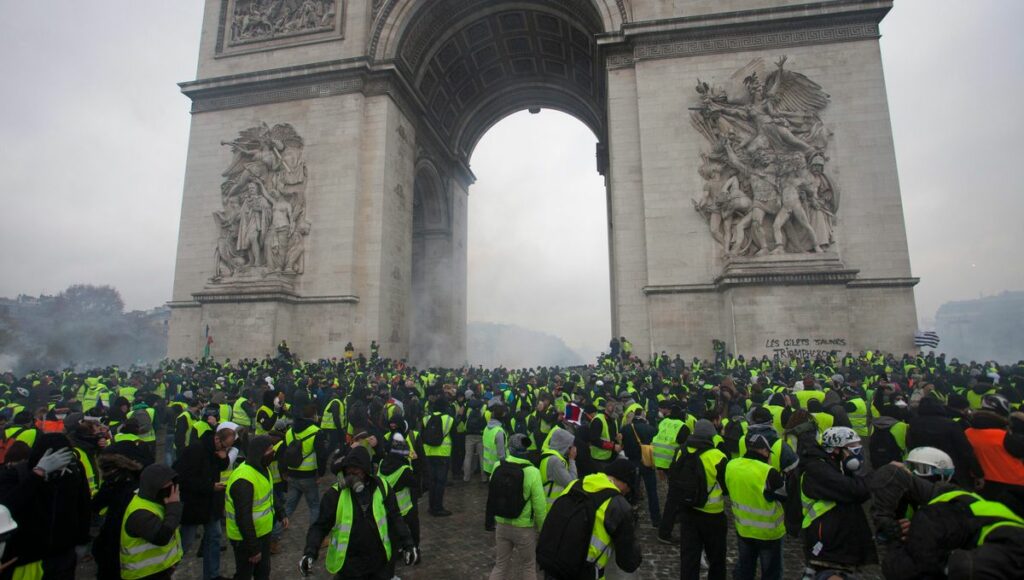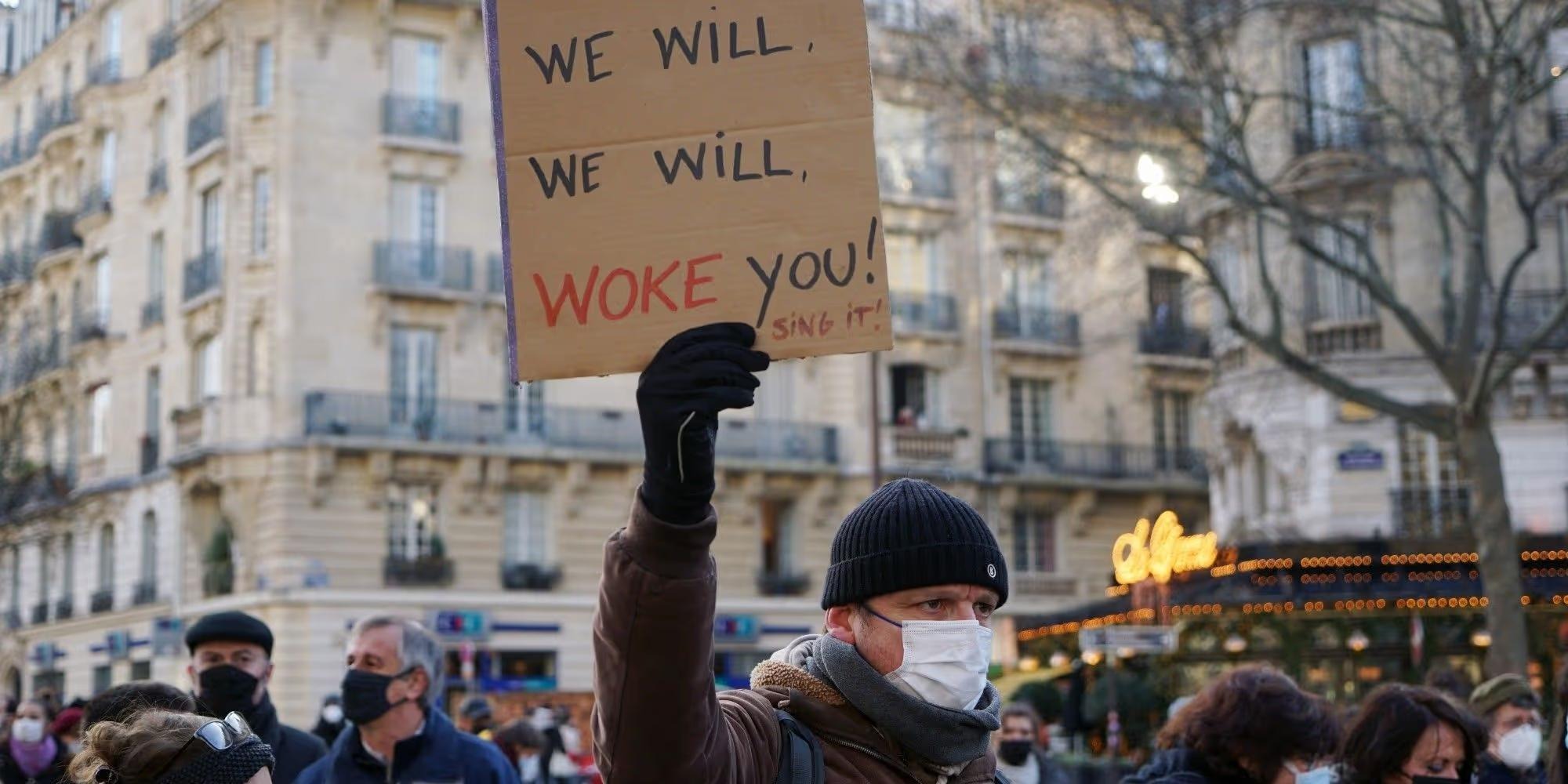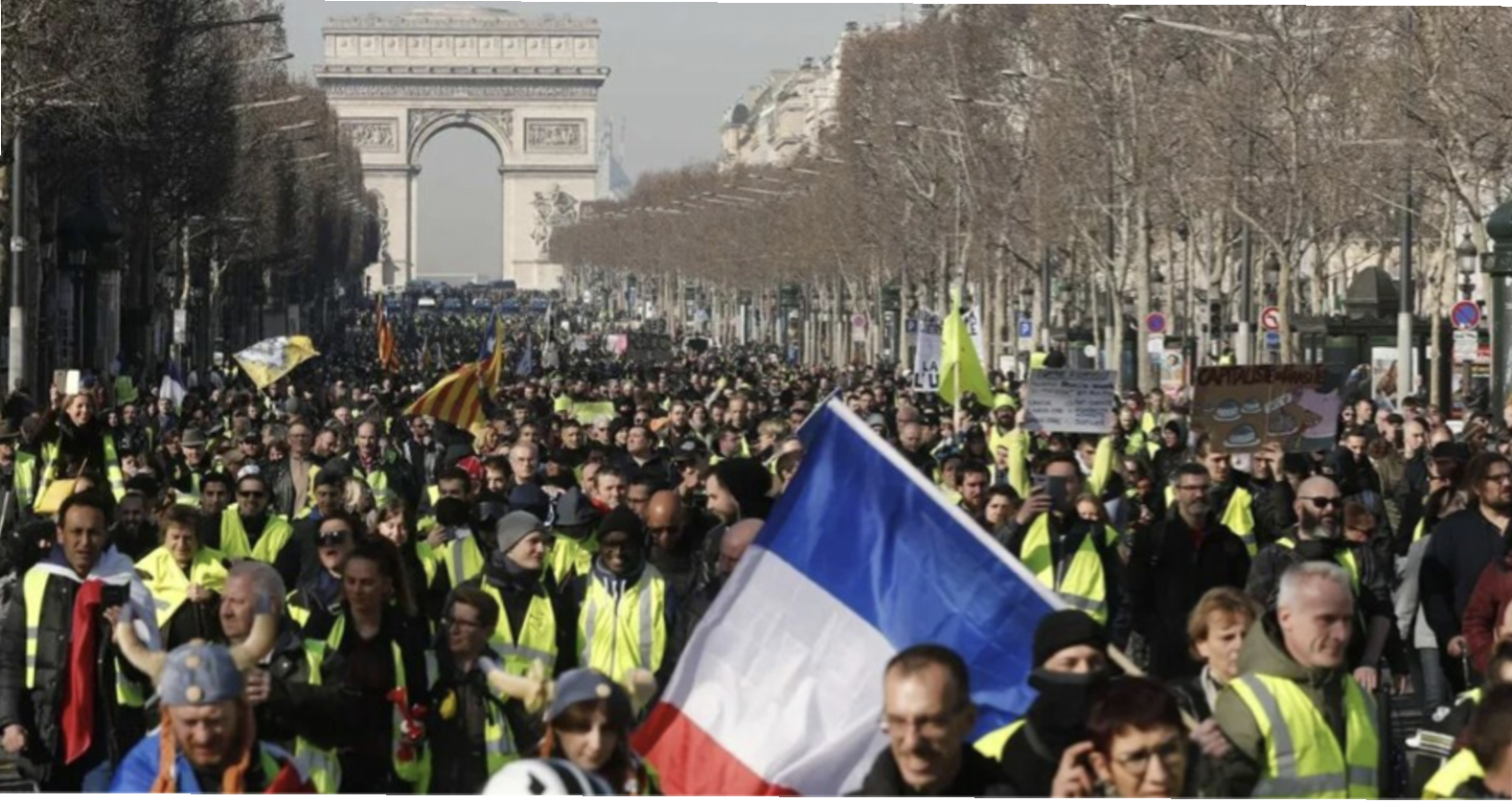We were very excited to see a popular uprising like the Yellow Vests in Europe. For some of us, this event was a trigger. There is a before and after the Yellow Vests. The fact that there are still people in this world with a political conscience, people who are eager to fight for justice and freedom, it gives us courage and strength.
The successes of the Yellow Vests
Before reviewing the mistakes of the Yellow Vests (GJ), we must highlight some undeniable tactical successes:
- Excellent ability to federate feelings of anger, to channel them into a powerful force that is potentially capable of triggering major changes in society[1] ;
- Use of a symbol (the vest) and a color (yellow) to increase the “tribe” effect and media visibility;
- Denunciation of permanent insecurity — precariousness, dependence, dependence, dependence, competition, terrorism, etc. — into which the globalized techno-industrial system plunges us[2] ;
- The choice of premises by occupying roundabouts and blocking roads everywhere in France;
- Highlighting an enormous need to fraternize, to create links and to associate[3] ;
- Spirit of initiative left to people that allowed maximum creativity;
- A struggle divided into several acts, just like in the theater[4] ;
- The GJs knew how to exploit social media and instant messaging to unite[5] ;
- By investing in Facebook, the GJs overwhelmed journalists, scientists, experts and politicians who used to get information on Twitter, allowing them to cut the wind out of the mainstream media in order to reach the masses.[6] ;
- Exaggerate national mobilization figures to encourage new people to join the movement.
The mistakes of the Yellow Vests
Lack of a clear and single objective
The Yellow Vests were formed in reaction to the carbon tax. While one of the main demands of a revolutionary nature seems to have been direct democracy, reformist tendencies were quickly added later, such as the citizens' initiative referendum (RIC), a tax reform or even the adoption of the proportional system for the parliamentary elections.
Mao Zedong said that efforts should be made to find the “main contradiction” in society in order to build an effective movement. During an asymmetric conflict, an organization that does not have a clearly defined objective, or that seeks to pursue multiple goals, will tend to collapse more quickly or degenerate. A lack of clarity naturally leads to a lack of understanding about where to go and creates fertile ground for internal divisions. Businesses, which are currently the dominant organizations in the world, use the SMART objective method (Specific, Measurable, Acceptable, Realistic, Timely Defined) to choose their strategic goals.
The other advantage of having a single objective lies in the optimized management of resources. In an asymmetric conflict, the weak camp can only rely on material, human and financial resources in quantities that are often very limited. The choice of a single objective is undeniable in terms of efficiency: to devote the maximum of resources to its achievement.

Overall lack of theory and strategy
“To optimize the effectiveness of the nonviolent struggle that we are preparing for, we must adopt a solid strategy, adapted to the conflict in question.”[7]
— Gene Sharp
The emergence of GJs in response to government fiscal policies, as well as its extremely rapid growth, has prevented solid theoretical and strategic foundations from being laid. It would have required a minimum of strategic planning before taking action, which is of course difficult and probably impossible during a hasty insurgency.
Without this preparatory work in advance, without an ideological framework to ensure cohesion and direct the “war effort” in the right direction, the movement ran out of steam as quickly as it emerged. According to political scientist Gene Sharp, strategy is the “design of the best way to act to achieve your goals during a conflict.”
There are four “levels” of strategy:
- The general strategy: the overall plan to guide the movement;
- Campaign strategies: they indicate how to manage specific conflicts as part of the overall struggle and overall strategy (example: the Sea Shepherd organization is conducting campaigns as part of its overall fight against the extermination of ocean life);
- Tactics: it foresees how the activists will act and the methods of action in a given situation;
- Specific methods: these are the methods of action used during operations.
For the sake of brevity, we will discuss this in more detail in other articles.
Lack of hierarchy and leaders
The Yellow Vests did not really have any identified leaders, it is a movement with no formal structure. Gradually, however, a few figures emerged: Éric Drouet, Maxime Nicolle, Maxime Nicolle, Priscilla Ludovsky, Jérôme Rodrigues, Thierry-Paul Valette or even Ingrid Levavasseur. However, as the movement was already launched, lacking an ideological structure as well as a clear objective and strategy to unify the movement's very disparate sensitivities, these natural leaders could do nothing to avoid disintegration. This one was Scheduled from the start.
Unfortunately, many activists seem to have an absurd aversion to any form of hierarchy, even when it allows individuals a great deal of autonomy. To argue their position, they put forward irrational beliefs and fallacies: leaders and hierarchy would be a right-wing thing; it would be easy to cut off the head of a hierarchical movement; companies, unions and political parties adopt hierarchical organizations, so hierarchy is bad; the biggest victory of GJs would be to have avoided hierarchy (we console ourselves as best we can); a hierarchical movement would automatically generate a despotic regime; etc.
There are several things that can be answered to this:
1) No resistance movement in history has succeeded in achieving anything without vision, strategy, and leaders. Even among the anarchists. Rojava had Abdullah Öcalan. Chiapas had Marcos. Ukraine had Makhno. Spain had Durruti. For other political resistance movements, same story. South Africa had Mandela. France had De Gaulle and Jean Moulin. Cuba had Fidel and Che Guevara. China had Mao. Russia had Lenin and Trotsky. The Black Panthers had Bobby Seale, Huey P. Newton, and Eldridge Cleaver.[8]. Ireland had Eamon de Valera and Michael Collins. Vietnam had Ho Chi Minh and Võ Nguyên Giáp. Guinea-Bissau had Amilcar Cabral. Burkina had Sankara. Bougainville had Francis Ona. Afghanistan had Massoud. Etc.
You will notice that most of these movements are positioned on the left on the political spectrum. We could go on for entire pages to list effective movements. We could also list all the headless, spontaneous and disorganized struggles that have failed and continue to fail, in France and elsewhere: the May 68 protests, Nuit Debout, Occupy Wall Street, Extinction Rebellion, Extinction Rebellion, the Extinction Rebellion, the Climate movement, the Climate movement, the Hippy Movement, the GJ, etc.
We could also cite a host of examples showing that the absence of a minimum of formal structure does not prevent the establishment of informal hierarchies. Under the guise of equality and benevolence, the most relentless of tyrannies can take place. Activist circles are literally plagued by these types of problems. As Theodore Kaczynski rightly wrote, “The leftist is motivated less by social discomfort than by his need to satisfy his power process by imposing his solutions on society.[9].” Individualism undermines the effectiveness of the struggle. In a movement we play collective, the ego and secondary disagreements must disappear in favor of the priority cause.

2) An opposition between two groups with contradictory objectives always requires a minimum of organization, because it is efficient. Some people have particular skills and excel in a specific field, others are simply lazy and cowardly.[10]. There are older people with some life experience, others who are younger are full of enthusiasm and can't keep up. Some personalities are psychologically stronger than others and manage to put aside their ego in order to devote themselves entirely to the cause. Some listen better and show humility, others are unable to. Organizing this diversity in order to achieve a specific objective requires a minimum of structure and organizers. This is even more true when the movement reaches a critical size. It is quite difficult to see how to work to achieve an objective without a minimum of organization with a group of 50 people, 500 or more... Let's add that during an attack, it is necessary to react quickly and in a coordinated manner, something impossible in a democratic framework. Elections have never been organized on a battlefield. Therefore, for all these reasons (and others that we probably forget) an organization that aims for final victory must be structured. Even lawless tribal societies have often formed chiefdoms and states to defend themselves against invaders, in a way that temporary[11].
That said, we are well aware that excessive hierarchy leads to bureaucracy and inefficiency. The whole art of strategy therefore lies in finding a structure that allows individuals sufficient autonomy and initiative, while ensuring that the movement progresses in the direction of the objective. To conclude on this point, millennia of history abound in this sense: a minimum framework is effective in building solid movements during a conflict. Denying it will lead irretrievably to defeat.
3) A hierarchical movement is not necessarily authoritarian and does not necessarily give rise to a totalitarian regime. In Ukraine at the beginning of the 20th century, the peasant anarchist Nestor Makhno led a revolution in the name of the peasantry without authoritarian tendencies. Unfortunately, other forces quickly neutralized Makhnovshchina. A few years later, Makhno wrote about the Russian anarchists crushed by the Bolsheviks that if they had been “closely linked organizationally and had observed a definite discipline in their actions, they would never have suffered such a defeat.[12].”
The same goes for Rojava, Chiapas, Bougainville Island, Ireland, etc. Again, this idea is based on the following fallacy: the means would systematically determine the end. This is only true in some cases. Here there is confusion between hierarchy and the objective pursued by a movement. If a movement aims to seize the State and use its power to impose a utopia on all the human groups that inhabit its territory, it has a good chance of evolving towards authoritarianism. It has been shown that a formal order imposed from above creates chaos rather than order[13]. On the other hand, if a movement aims to dismantle the material conditions — means of communication, energy infrastructures and transport networks — that underlie the constitution of centralized power, the establishment of a despotic regime becomes practically impossible.[14].
4) The leaders of victorious movements are not systematically murdered. First, examples abound of effective movements that achieved their goals without losing their leaders. And you only have to look at the personality cult dedicated to Thomas Sankara and Patrice Lumumba in Africa to come to the conclusion that every assassinated leader immediately becomes a martyr.[15]. The underground newspapers of the French resistance regularly published lists of fighters assassinated by the enemy to create a legend, arouse admiration and vocations.[16].

Tactical mistakes
This list is not exhaustive.
Demonstrate in Paris
Believing that all problems can be resolved in the capital is an old French reflex probably inherited from the Revolution of 1789. But we are no longer in the 18th century. First, following the repeated Parisian insurrections at the beginning of the 19th century, the architecture of the avenues was redesigned under Napoleon III to facilitate the maintenance of order.[17]. This modification reduces the friction effect of the terrain. In asymmetric combat, smooth, flat terrain greatly benefits the most powerful army. The camp with limited resources must strive to fight its opponent on terrain where the friction effect is maximum (example: forests, swamps, mountains). Note that the construction of barricades serves, among other things, to increase this friction effect, but it is much more difficult to build them on major boulevards.
On the other hand, power in today's industrialized world is concentrated in large bureaucratic and economic organizations. Their power is based entirely on material elements, mainly energy, transport and communication infrastructures. The latter guarantee, for example, a modern state — or private militias — the capacity to intervene and control the entire territory “colonized” by said infrastructures. Moreover, by making the entire population of a given territory dependent on these infrastructures for their subsistence (food, energy), the large private and state industrial firms have succeeded in imposing an overwhelming material domination. Thus, storming the capital will certainly create some disturbances in the locality, but it is not likely to fundamentally change the unequal distribution of power within French society. It would have been better to stay in the regions, on roundabouts and roads.
The destruction of symbols
The looting and destruction of property has only a symbolic meaning, as their impact is negligible in terms of effectiveness. Although it may be pleasant to see the bourgeois on TV sets fear the people, it must be admitted that the deterioration of the Arc de Triomphe and on the Champs Élysées ultimately did little to advance the cause of the GJ. Power is based above all on material resources — technologies — and not on symbols. Add to this that the ransacking of a symbol was a blessing for the government, which was just waiting for it to intensify the repression of the movement. It is important to understand that we are not making moral judgments here. The question is not whether it is a good or a bad thing to ransack a monument, but to assess, in view of the consequences, whether or not this action increased the material power of the Yellow Vests movement.

Victimization
The last tactical error that comes to mind: the communication of the GJs concerning the injured during the clashes with the police. According to figures given by Wikipedia, there were nearly 25,800 injured, including 2,500 serious enough to have been treated by the firefighters. The injured were often presented as victims, to highlight police brutality. Such communication sows the seeds of fear and demoralizes people in the movement. On the contrary, it seems to us that a movement seeking psychological dominance over its enemy should present its wounded as heroes and martyrs. You have to create a legend, glorify risk taking and sacrifice. Again, all this must be thought of beforehand, hence the need for preparation and a strategy.
The Yellow Vests movement was beneficial. He recalled that the revolution was still fully current. As long as there is injustice, as long as there is an elite of parasites who concentrate power in their hands, there will be revolutionaries. This is a law of history. We hope that this modest contribution will serve to increase the effectiveness of future fighting.







